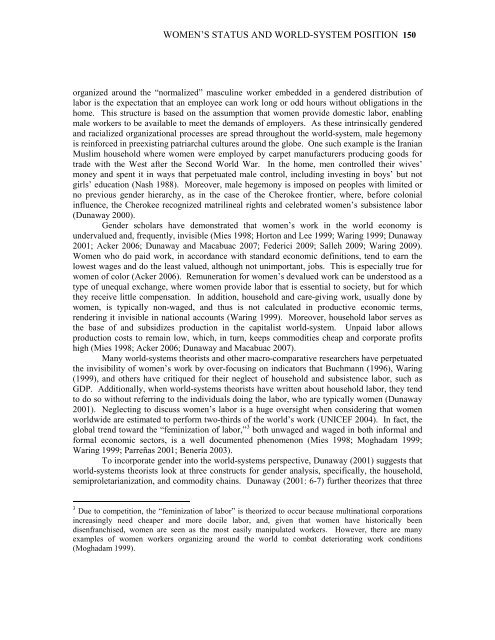Entire Volume 17 issue 1 - Journal of World-Systems Research ...
Entire Volume 17 issue 1 - Journal of World-Systems Research ...
Entire Volume 17 issue 1 - Journal of World-Systems Research ...
Create successful ePaper yourself
Turn your PDF publications into a flip-book with our unique Google optimized e-Paper software.
WOMEN’S STATUS AND WORLD-SYSTEM POSITION 150<br />
organized around the “normalized” masculine worker embedded in a gendered distribution <strong>of</strong><br />
labor is the expectation that an employee can work long or odd hours without obligations in the<br />
home. This structure is based on the assumption that women provide domestic labor, enabling<br />
male workers to be available to meet the demands <strong>of</strong> employers. As these intrinsically gendered<br />
and racialized organizational processes are spread throughout the world-system, male hegemony<br />
is reinforced in preexisting patriarchal cultures around the globe. One such example is the Iranian<br />
Muslim household where women were employed by carpet manufacturers producing goods for<br />
trade with the West after the Second <strong>World</strong> War. In the home, men controlled their wives’<br />
money and spent it in ways that perpetuated male control, including investing in boys’ but not<br />
girls’ education (Nash 1988). Moreover, male hegemony is imposed on peoples with limited or<br />
no previous gender hierarchy, as in the case <strong>of</strong> the Cherokee frontier, where, before colonial<br />
influence, the Cherokee recognized matrilineal rights and celebrated women’s subsistence labor<br />
(Dunaway 2000).<br />
Gender scholars have demonstrated that women’s work in the world economy is<br />
undervalued and, frequently, invisible (Mies 1998; Horton and Lee 1999; Waring 1999; Dunaway<br />
2001; Acker 2006; Dunaway and Macabuac 2007; Federici 2009; Salleh 2009; Waring 2009).<br />
Women who do paid work, in accordance with standard economic definitions, tend to earn the<br />
lowest wages and do the least valued, although not unimportant, jobs. This is especially true for<br />
women <strong>of</strong> color (Acker 2006). Remuneration for women’s devalued work can be understood as a<br />
type <strong>of</strong> unequal exchange, where women provide labor that is essential to society, but for which<br />
they receive little compensation. In addition, household and care-giving work, usually done by<br />
women, is typically non-waged, and thus is not calculated in productive economic terms,<br />
rendering it invisible in national accounts (Waring 1999). Moreover, household labor serves as<br />
the base <strong>of</strong> and subsidizes production in the capitalist world-system. Unpaid labor allows<br />
production costs to remain low, which, in turn, keeps commodities cheap and corporate pr<strong>of</strong>its<br />
high (Mies 1998; Acker 2006; Dunaway and Macabuac 2007).<br />
Many world-systems theorists and other macro-comparative researchers have perpetuated<br />
the invisibility <strong>of</strong> women’s work by over-focusing on indicators that Buchmann (1996), Waring<br />
(1999), and others have critiqued for their neglect <strong>of</strong> household and subsistence labor, such as<br />
GDP. Additionally, when world-systems theorists have written about household labor, they tend<br />
to do so without referring to the individuals doing the labor, who are typically women (Dunaway<br />
2001). Neglecting to discuss women’s labor is a huge oversight when considering that women<br />
worldwide are estimated to perform two-thirds <strong>of</strong> the world’s work (UNICEF 2004). In fact, the<br />
global trend toward the “feminization <strong>of</strong> labor,” 3<br />
both unwaged and waged in both informal and<br />
formal economic sectors, is a well documented phenomenon (Mies 1998; Moghadam 1999;<br />
Waring 1999; Parreñas 2001; Benería 2003).<br />
To incorporate gender into the world-systems perspective, Dunaway (2001) suggests that<br />
world-systems theorists look at three constructs for gender analysis, specifically, the household,<br />
semiproletarianization, and commodity chains. Dunaway (2001: 6-7) further theorizes that three<br />
3 Due to competition, the “feminization <strong>of</strong> labor” is theorized to occur because multinational corporations<br />
increasingly need cheaper and more docile labor, and, given that women have historically been<br />
disenfranchised, women are seen as the most easily manipulated workers. However, there are many<br />
examples <strong>of</strong> women workers organizing around the world to combat deteriorating work conditions<br />
(Moghadam 1999).





